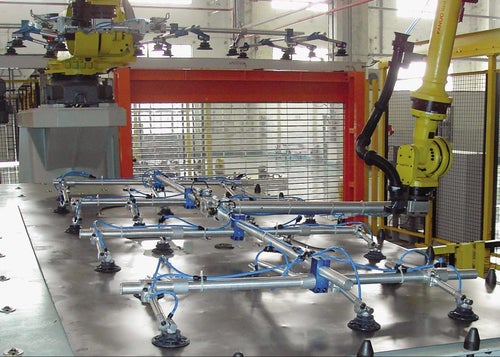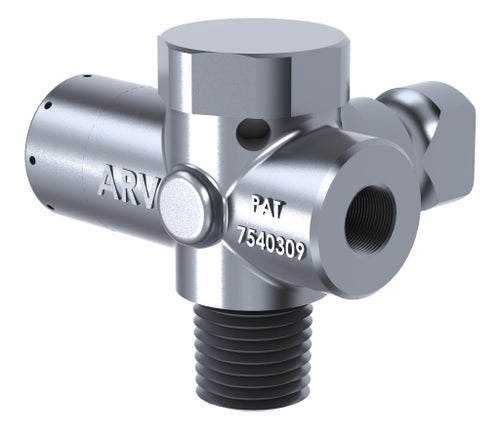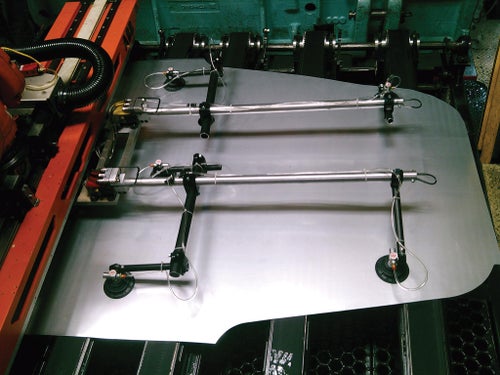How To Increase Uptime In Your Press Shops
Next generation, lightweight tooling systems and components are optimizing stamping process safety, speed, uptime, cost and standardization - creating more efficient and reliable operations to satisfy stringent production demands.
Production schedules are relentless. Missing deadlines decreases revenue for press shops that rely on eliminating downtime and increasing efficiency with next-generation lightweight tooling. Vacuum cups, end effector tooling systems and magnets are all utilized to pick, place and secure stamping materials. These tools have advanced in design and capabilities, and successful shops utilize these components – including the newest robotics systems.
For example, lightweight tooling constructed of high-strength, aircraft aluminum that can weigh up-to 50 percent less than traditional steel components helps improve press shop performance in four critical areas:
- Vibration – Because of their smaller mass, lightweight aluminum end effectors reduce the amount of vibration that can occur during pick-up and drop-off. Less vibration means less strain on the lifting system, which equates to positioning accuracy, and reduced maintenance and downtime.
- Robot size – Lighter end effectors can be controlled by smaller robots. In turn, smaller robots work faster and more efficiently than the high-payload, pick-and-place robots.
- Speed – For end effectors, lightweight means faster. Some aluminum end effector models can perform up-to 30 percent faster than heavier alternatives. Lighter components are also easier to change-out, meaning a tool change that takes a half an hour can be performed in ten minutes or less. This speed, combined with improved accuracy and efficiency, means higher production output and a healthier overall equipment effectiveness. (OEE)
- Operator safety – Handling heavy tools and components puts strain on your staff. With the newest end effectors weighing up to 50 percent less than traditional tooling, operators are less likely to experience back strain or injury.

Benefits to Optimizing Your Tool Changers
Optimizing your system’s tool changers can significantly improve manufacturing performance. This is seen in automatic tool-changing technology, which has grown in recent years due to improved robot effectiveness. Automatic tool-changing systems allow a robot to remove and drop-off an end effector on a tool stand and replace it with another one, all without operator input. This efficiency helps plants during unique, part-moving jobs and helps reduce your setup costs.
Successful shops usually incorporate a simplified “semi-automatic” approach to tool changes that uses both a robot and a human operator with a two-tool stand, rather than more complicated tool stands that can accommodate upwards of ten end effectors. In this two-tool system, the robot drops off one end effector and grabs the next one.
While that is being completed, the operator removes the end effector branches from the first tool stand and replaces them with new tooling. The benefit is that the press can run while the manual end effector change occurs, improving uptime and reducing the space that a five, ten or 15-tool stand requires. The lightweight, modular design of aluminum end effector parts also makes it easier to keep replacement parts in-stock, helping reduce time needed to change a tool from two hours to 15-30 minutes.
This combination of automatic and manual tool-changing processes is also known as the “World Tool”: defined by when the tool-changing setup is built around a strong main boom that is attached to an automatic tool changer that is controlled by a robot at one end and a manual tool changer, where lighter end effector branches are situated, at the other end. By using the World Tool, lighter components can improve production speeds by up to 30 percent, improve safety, are ergonomically friendly, and become less susceptible to expensive wear and tear.

The Importance of Vacuum Cups
Though vacuum cups are the smallest components in an end effector system, they have big responsibilities. To maximize their benefits, the manufacturer must know the characteristics of the object being lifted, moved and replaced, as well as how the object determines the type of vacuum cup that should be used.
These characteristics include:
- Material Type - Material types generally fall into one of two categories: porous or non-porous. Porous materials include such items as cardboard, wood and Styrofoam, all of which generally require higher vacuum flow but don’t require high-level vacuum generation in order to be lifted. Non-porous materials (steel, aluminum, hard plastic, etc.) require a lower vacuum flow to be picked-up.
- Surface Type - Surface types fall into one of two categories: dry or oily. Most objects are dry, but there are classes of plastics that may have oily surfaces. There are also sheet metals that are treated with a rust-inhibitor before undergoing a stamping process, leaving an oily sheen on the surface. Selecting the correct tread on a vacuum cup will ensure proper handling.
- Contour - Determining the contour requires answering this question: Is it flat, or does it have rounded edges or curves? Some objects may have too many curves or undulations, so a vacuum cup may not work. Also, objects that have too many closely-spaced holes are not compatible with vacuum cups.
- Shape - There have traditionally been two choices in vacuum-cup shape: round or oval. Round vacuum cups are the most common, but if the application requires grabbing a very thin object, a long oval vacuum cup may be required. New bell-shaped vacuum cups are growing in popularity because their bodies can adhere to convex or concave surfaces through a refined internal friction pattern that can withstand high shear forces.
Within the various vacuum-cup families there are two design types:
- Bellows-style - The bellows-style vacuum cup has an accordion design that makes it more flexible, allowing it to pick up items that don’t have a consistent shape or are not well-aligned with the cup. This is possible though a higher vacuum flow that removes large volumes of air inside.
- Shape - Flat vacuum cups require less air to be removed to create a grip but are not as flexible as bellows-style cups.

Measuring Vacuum Cup Hardness
One of measures of material hardness, “durometer” is typically used for polymers, elastomers and rubbers. Most vacuum-cup suppliers use the Shore A scale when testing for durometer. Higher numbers indicate harder materials, while lower numbers indicate softer materials. Both rubber and polyurethane-based standard cups on the market today will use this same scale to measure durometer:
- 30-Durometer - A softer durometer that’s ideal for contoured panels but may have a shorter life cycle than harder durometer vacuum cups.
- 45-Durometer - A medium-hard rubber that seals and adapts to most contours, which makes it good for all-around usage. This rubber generally has a longer operational life than a 30-durometer vacuum cup.
- 60-Durometer - The hardest durometer is effective with oily, flat surfaces. Its life is longer than that of a 45-durometer vacuum cup.
Some vacuum cup suppliers will color-code their products by durometer for easy identification, maintenance and replacement. When choosing a durometer for your application, remember that contoured parts, or those with sharp corners or edges, need a softer durometer so that the vacuum cups can hug the contours easier. Flat surfaces are ideal for a harder durometer because a vacuum cup constructed of that material will have stronger holding properties.
Tread Pattern
Like vehicle tires, many vacuum cups have their own unique tread pattern. This pattern helps determine the holding power or grip of the vacuum cup on the surface of the material to be transferred. What works in one application may not work in another, especially if the material’s surface is dry or oily. Some vacuum cups combine their unique treads with multiple durometers to help increase grip strength.
Mounting Type
A wide range of mounting types are available: male/female Imperial NPT and Metric-G threads, square T-mount, and quick disconnect. New lightweight plastic-thread mounts are also coming to the market. Vacuum cup manufacturers have created products that will satisfy the needs of the end user’s preferred mounting type. Before choosing a mounting type, it is wise to consult with the manufacturer to determine what type of automation system is being used; because if the vacuum cup doesn’t fit on the mount, your system won’t operate.
For supplying the air that allows the vacuum cups to operate, venturi systems are globally accepted. Yet, the configuration and operation of the venturi-based system has changed. Traditional systems operate with two air lines: one to create the vacuum that allows objects to be picked up and a second that adds air into the cup, dropping the part. The second blow-off line can be unreliable in its operation, resulting in misplaced and uneven drops that can hamper the robot and tool-changing system.
A Range Of Tooling Components
A variety of additional components and accessories can optimize press shop performance. Many press shop equipment suppliers have developed stamping-system components that look the same and have the same design that benefits users around the world: for example, if a job is specified for a factory in Detroit, the manufacturer knows that the same components and systems can be used and serviced at a similar facility in China.
Other innovations in recent years have helped operators produce more stamped parts per hour while reducing overall system wear and tear, including:
- Sheet-Metal Grippers - A reworked design makes the sheet metal gripper lighter and compact, without reduction in grip force. This allows them to function seamlessly with lightweight tooling components.
- Proximity Switch Mounts - These mounts are constructed of high-strength, glass-filled nylon to withstand the high sensitivity of the aluminum-sensing proximity switches that are used in increasingly popular robotic pick-and-place material handling lines.
- Rotaries - These rotaries can be used with end effector and sheet-metal grippers for an automated solution in tri-axis press applications. Low-profile rotaries also help ensure precision positioning. A vital area to consider are the use of magnets as a way to pick-up, move and place parts and/or finished products.
Choosing the Right Magnets
One final area to consider are the use of magnets as a way to pick-up, move, and place parts and/or finished products. Ideally, powerful Rare Earth magnets can be used in applications where typical vacuum cups or grippers are not effective, such as lifting and moving heavy steel sheets, blanks, stamped parts and even complete assemblies in station-to-station, press-to-press and robotic pick-and-place systems.
Contact our press shop experts to share your application goals and technical specifications today!
